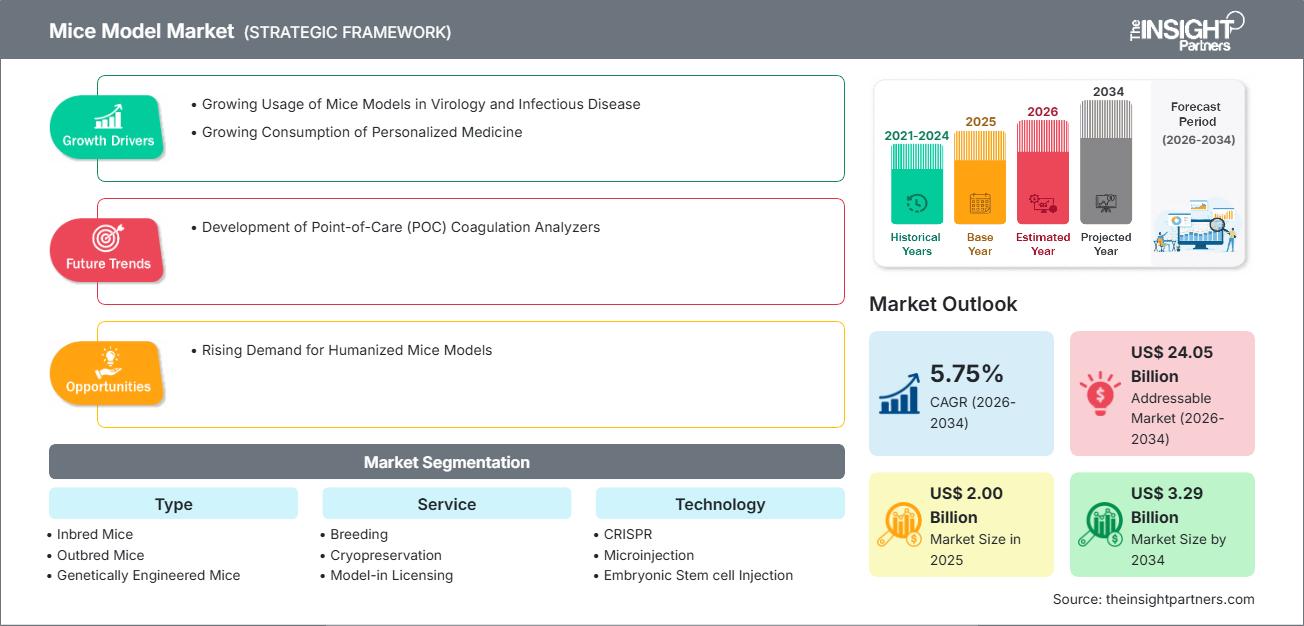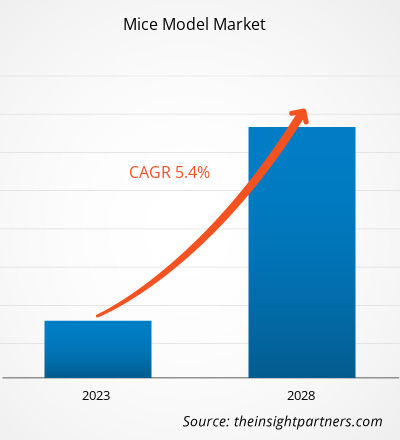The Mice Model Market size is forecast to experience steady expansion, projected to reach US$ 3.29 billion by 2034, rising from US$ 2.00 billion in 2025. The market is anticipated to register a Compound Annual Growth Rate (CAGR) of 5.75% during the forecast period of 2026–2034.
Mice Model Market Analysis
The global mice model market forecast indicates stable and predictable growth, primarily driven by the consistent and escalating demand for high-quality preclinical research models across the pharmaceutical and biotechnology sectors. This growth is significantly bolstered by groundbreaking advancements in genetic engineering technologies, most notably CRISPR/Cas9, which enable the rapid and precise creation of complex, humanized models. As the global incidence and complexity of chronic diseases, particularly cancer, continue to rise, there is an ever-increasing requirement for in vivo systems to facilitate drug discovery, conduct rigorous toxicology studies, and accelerate the development of personalized medicine approaches. The market is witnessing greater collaboration between academic research institutions and commercial model providers to industrialize the supply chain of specialized models.
Mice Model Market Overview
Mice models are indispensable assets in modern biomedical research, serving as critical platforms for elucidating disease pathology, assessing the efficacy of novel therapeutic compounds, and conducting comprehensive safety and toxicity evaluations. The market encompasses a wide array of models, including standard inbred and outbred strains, highly specialized genetically engineered (transgenic, knockout, knock-in) models, and increasingly complex humanized mice. Market dynamics are characterized by intensive Research and Development (R&D) investments, particularly in developing models that better mimic human conditions. Key technological adoption trends include the widespread use of gene-editing techniques like CRISPR, as well as the integration of stem cell-based approaches to improve model relevance.
Customize This Report To Suit Your Requirement
You will get customization on any report - free of charge - including parts of this report, or country-level analysis, Excel Data pack, as well as avail great offers and discounts for start-ups & universities
Mice Model Market: Strategic Insights

-
Get Top Key Market Trends of this report.This FREE sample will include data analysis, ranging from market trends to estimates and forecasts.
Mice Model Market Drivers and Opportunities
Market Drivers:
- Rising Demand for Preclinical Studies in Drug Development: Mandatory regulatory requirements and the need for robust efficacy and safety data necessitate the use of in vivo animal models, driving the fundamental demand for laboratory mice in the drug pipeline.
- Advancements in Genetic Engineering Technologies Including CRISPR: The revolutionary precision and speed of gene-editing tools such as CRISPR/Cas9 have dramatically lowered the barrier to creating highly specific mouse models, significantly accelerating disease modeling and target validation.
- Growing Prevalence of Cancer and Other Chronic Diseases: The increasing global prevalence of complex illnesses, especially oncology and neurodegenerative disorders, necessitates more relevant and sophisticated animal models to understand disease mechanisms and test targeted therapies effectively.
Market Opportunities:
- Development of Humanized Mice Models for Personalized Medicine: The creation of humanized mice, often engineered to possess human immune systems or specific human gene sequences, represents a major opportunity, allowing for more clinically predictive preclinical testing tailored for specific patient populations.
- Expansion in Emerging Markets with Increasing Research Infrastructure: Countries in the Asia-Pacific and Latin America regions are rapidly investing in biomedical research infrastructure and clinical trial capabilities, opening new avenues for commercial model providers to expand their service and supply networks.
- Strategic Partnerships Between Contract Research Organizations (CROs) and Pharmaceutical Companies: Closer integration between CROs that utilize mice models and pharmaceutical companies that develop drugs allows for customized model creation and integrated preclinical testing services, optimizing research timelines and resource utilization.
Mice Model Market Report Segmentation Analysis
The Mice Model Market share is analyzed across various segments to illustrate the range of models, supporting services, utilized technologies, and primary indications driving demand. Below is the standard segmentation approach used in most industry reports:
By Type:
- Inbred Mice
- Outbred Mice
- Genetically Engineered Mice
- Hybrid Mice
- Surgically Modified Mice
- Spontaneous Mutant Mice
By Service:
- Breeding
- Cryopreservation
- Model-in Licensing
- Genetic Testing
- Quarantine
By Technology:
- CRISPR
- Microinjection
- Embryonic Stem Cell Injection
- Nuclear Transfer
By Indication:
- Oncology Studies
- Immunology & Inflammation Studies
- Endocrine Metabolic Studies
- Cardiovascular Studies
- Central Nervous System
By Geography:
- North America
- Europe
- Asia Pacific
- South & Central America
- Middle East & Africa
Mice Model Market Regional Insights
The regional trends and factors influencing the Mice Model Market throughout the forecast period have been thoroughly explained by the analysts at The Insight Partners. This section also discusses Mice Model Market segments and geography across North America, Europe, Asia Pacific, Middle East and Africa, and South and Central America.
Mice Model Market Report Scope
| Report Attribute | Details |
|---|---|
| Market size in 2025 | US$ 2.00 Billion |
| Market Size by 2034 | US$ 3.29 Billion |
| Global CAGR (2026 - 2034) | 5.75% |
| Historical Data | 2021-2024 |
| Forecast period | 2026-2034 |
| Segments Covered |
By Type
|
| Regions and Countries Covered |
North America
|
| Market leaders and key company profiles |
|
Mice Model Market Players Density: Understanding Its Impact on Business Dynamics
The Mice Model Market is growing rapidly, driven by increasing end-user demand due to factors such as evolving consumer preferences, technological advancements, and greater awareness of the product's benefits. As demand rises, businesses are expanding their offerings, innovating to meet consumer needs, and capitalizing on emerging trends, which further fuels market growth.

- Get the Mice Model Market top key players overview
Mice Model Market Share Analysis by Geography
North America holds the largest market share, with the Asia-Pacific region exhibiting the highest CAGR during the forecast period.
The market growth trajectory varies by region, influenced by factors such as government research funding, pharmaceutical industry presence, and regulatory oversight of animal research. Below is a summary of market share and trends by region:
North America
- Market Share: Dominates the global market due to the massive presence of major pharmaceutical and biotech companies, substantial government and private funding for biomedical research, and a highly established network of commercial model providers.
- Key Drivers: Leading adoption rate of advanced genetically engineered and humanized models.
- Trends: Increasing outsourcing of model development and maintenance services to specialized vendors, and a focus on models for complex, personalized cancer therapy research.
Europe
- Market Share: Holds a significant share, supported by strong government-funded research programs (e.g., Horizon Europe), strict regulatory frameworks ensuring quality, and major academic research clusters.
- Key Drivers: Collaborative projects across multiple European nations requiring standardized model supply.
- Trends: Emphasis on developing and sharing standardized, high-quality models across research networks to enhance reproducibility, often focused on infectious diseases and rare genetic disorders.
Asia-Pacific
- Market Share: Fastest-growing region globally, fueled by rapid investments in the biomedical research sector, expanding domestic pharmaceutical industries, and increasing clinical research activities, particularly in China and India.
- Key Drivers: Establishment of new, state-of-the-art research centers and biotech hubs.
- Trends: Fast growth in demand for both standardized models for toxicology screening and complex GEM models to support a burgeoning drug discovery pipeline.
South and Central America
- Market Share: Emerging market with developing research capabilities and expanding clinical research activities, especially in vaccine and infectious disease research.
- Key Drivers: Growing need for specialized models for region-specific diseases.
- Trends: Focus on establishing local breeding and maintenance facilities to ensure a stable supply of high-quality, regionally relevant models.
Middle East and Africa
- Market Share: Developing market with growth potential driven by government investments in creating world-class healthcare and research facilities as part of broader economic diversification efforts.
- Key Drivers: Demand for models to study region-specific infectious diseases and genetic disorders.
- Trends: Partnerships with global suppliers to import high-quality models and transfer technology for local breeding and genetic manipulation.
Mice Model Market Players Density: Understanding Its Impact on Business Dynamics
The competitive landscape is defined by a few global giants who dominate model supply and distribution, alongside highly specialized, technology-focused companies focusing on cutting-edge genetic engineering. Major vendors prioritize model quality, genetic integrity, and scientific support services.
This competitive environment pushes vendors to differentiate through:
- Genetic Precision and Quality: Ensuring the highest genetic purity and health standards for every model supplied, backed by rigorous quality control and genetic testing services.
- Speed of Model Generation: Utilizing advanced technologies like CRISPR to dramatically reduce the time required to develop a custom genetically engineered mouse model.
- Scientific Service Integration: Offering end-to-end services, from model design and breeding to in vivo pharmacology and phenotyping studies, providing complete research solutions.
Major Companies operating in the Mice Model Market are:
- Charles River Laboratories
- The Jackson Laboratory
- Taconic Biosciences
- GenOway S.A.
- Envigo (Inotiv, Inc.)
- TRANS GENIC INC.
- Janvier Labs
- Ozgene Pty Ltd.
- Crown Bioscience Inc.
Disclaimer: The companies listed above are not ranked in any particular order.
Mice Model Market News and Recent Developments
- Charles River Laboratories announced enhancements to its International Genetic Standardization (IGS) program, offering a wide range of immunodeficient, transgenic, and humanized mouse models. The company introduced advanced humanized NCG and PBMC models and the rasH2 transgenic mouse for accelerated carcinogenicity testing, supporting oncology and toxicology research.
- The Jackson Laboratory unveiled the CAST/EiJ strain, naturally susceptible to severe COVID-19 variants, enabling vaccine and therapeutic testing without genetic modification. Additionally, JAX introduced mouse models for alternating hemiplegia of childhood (AHC) and advanced work on genetically engineered models for late-onset Alzheimer’s disease (LOAD) using CRISPR and transgenes based on human risk factors.
- Envigo expanded its portfolio with B-NDG hIL15 mice expressing human IL-15 for NK-cell development and B-NDG B2m models optimized for IgG pharmacokinetics. The company also completed the acquisition of Horizon Discovery’s research models unit, integrating CRISPR-edited mice into its offerings for advanced genetic research.
Mice Model Market Report Coverage and Deliverables
The "Mice Model Market Size and Forecast (2021–2034)" report provides a detailed analysis of the market covering below areas:
- Mice Model Market size and forecast at global, regional, and country levels for all the key market segments covered under the scope.
- Mice Model Market trends, as well as market dynamics such as drivers, restraints, and key opportunities.
- Detailed PEST and SWOT analysis.
- Mice Model Market analysis covering key market trends, global and regional framework, major players, regulations, and recent market developments.
- Industry landscape and competition analysis covering market concentration, heat map analysis, prominent players, and recent developments in the Mice Model Market.
- Detailed company profiles.
Frequently Asked Questions
Which geographical region leads the adoption and supply of mice models?
Which Indication segment leads the demand for mice models?
What are the key drivers of the Mice Model Market growth?
Which Type of mouse model holds the largest market share?
What is the current size of the global Mice Model Market?
- Historical Analysis (2 Years), Base Year, Forecast (7 Years) with CAGR
- PEST and SWOT Analysis
- Market Size Value / Volume - Global, Regional, Country
- Industry and Competitive Landscape
- Excel Dataset
Recent Reports
Testimonials
Reason to Buy
- Informed Decision-Making
- Understanding Market Dynamics
- Competitive Analysis
- Identifying Emerging Markets
- Customer Insights
- Market Forecasts
- Risk Mitigation
- Boosting Operational Efficiency
- Strategic Planning
- Investment Justification
- Tracking Industry Innovations
- Aligning with Regulatory Trends





















 Get Free Sample For
Get Free Sample For